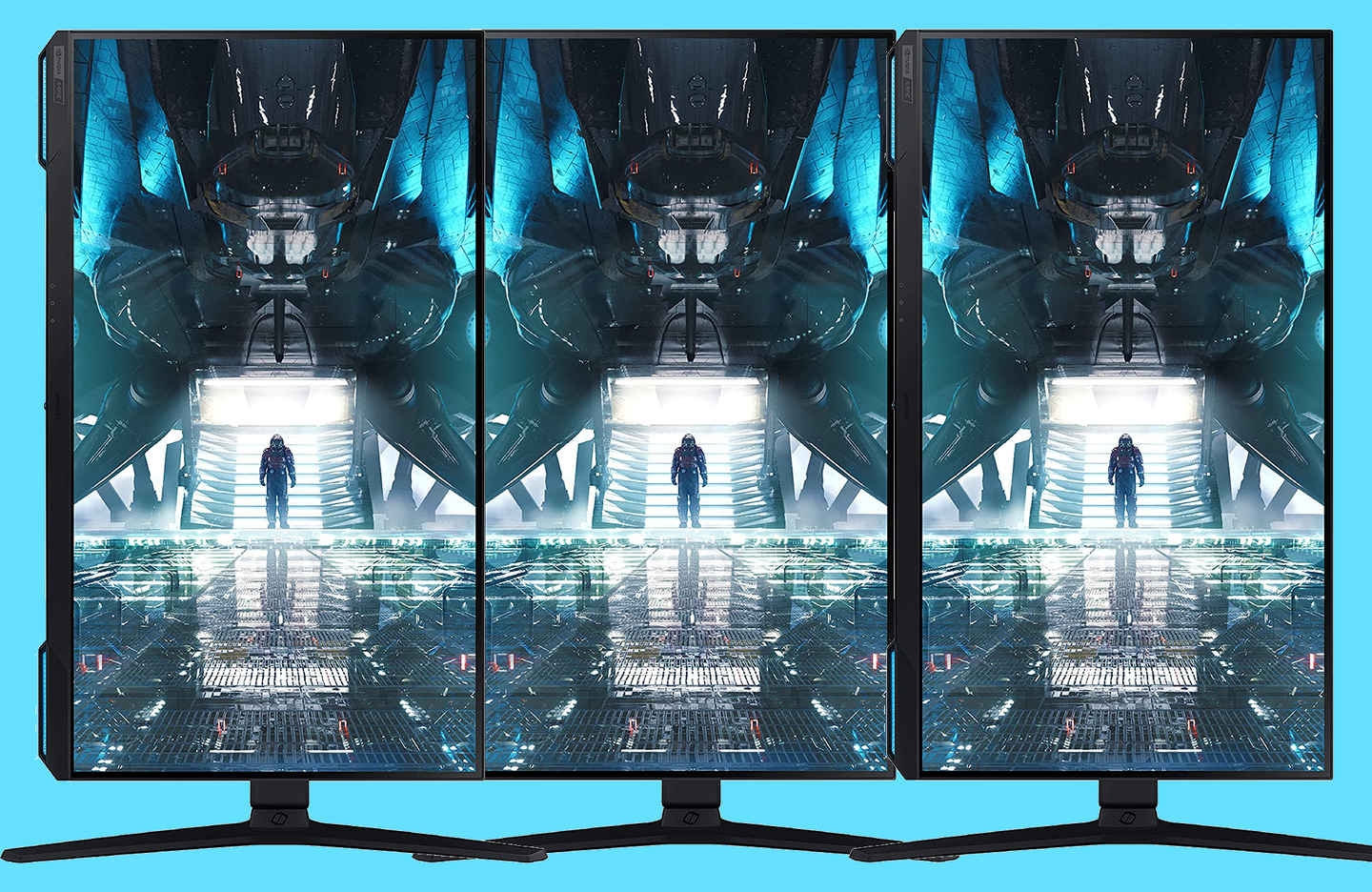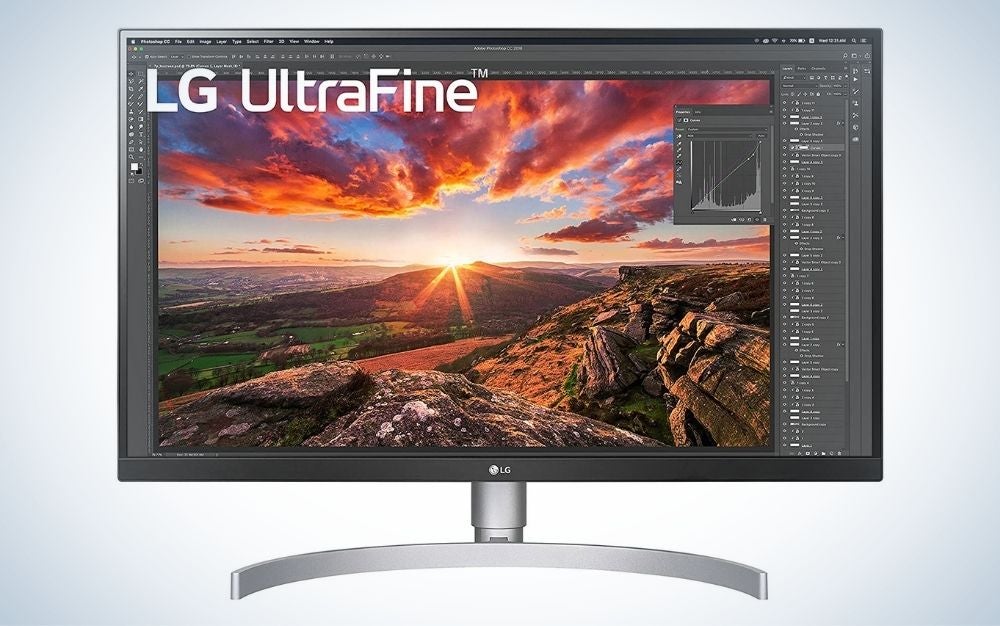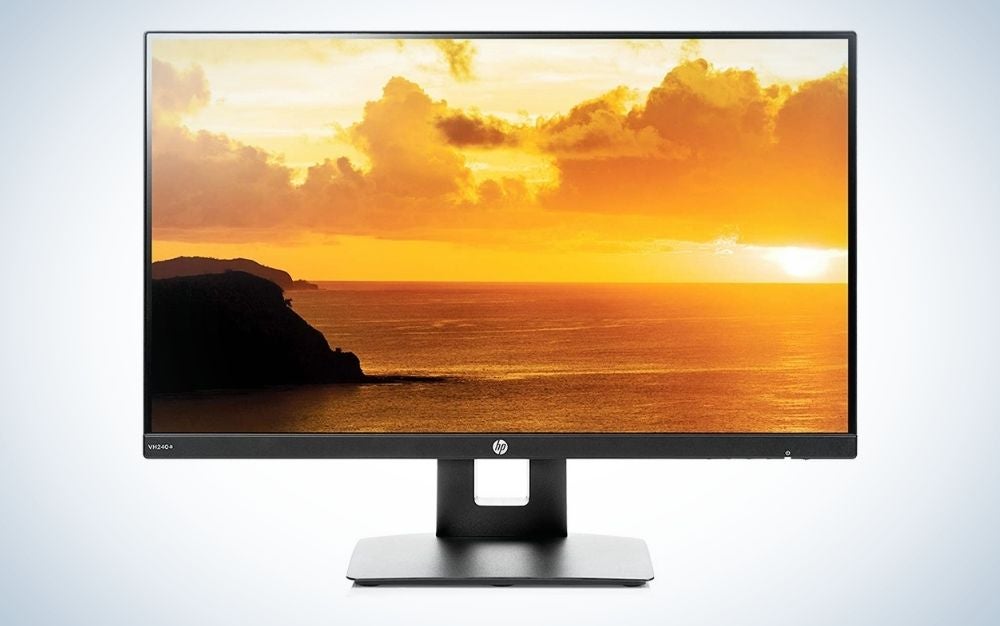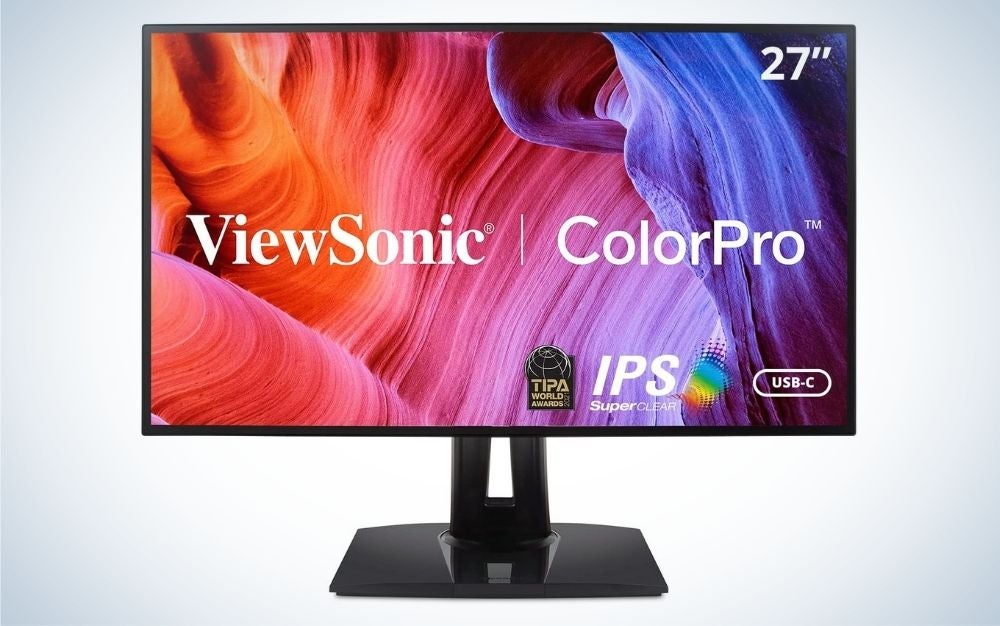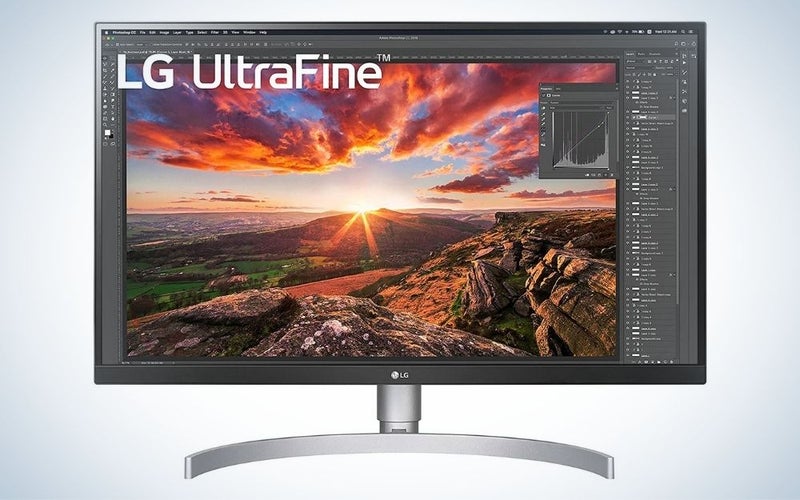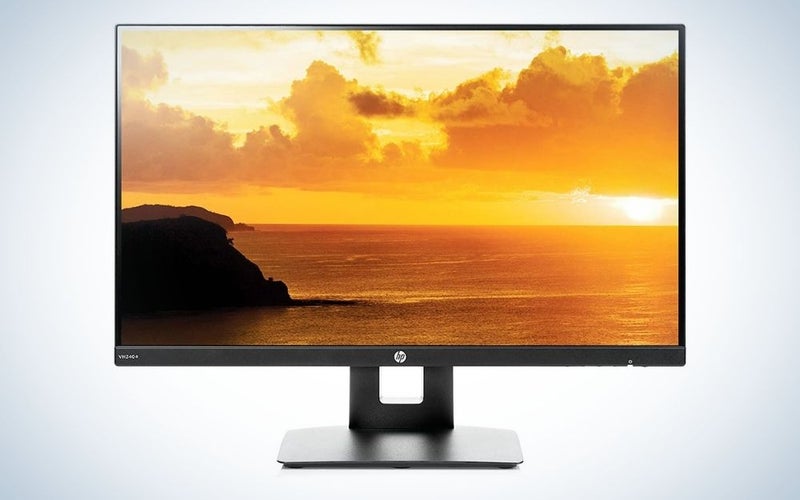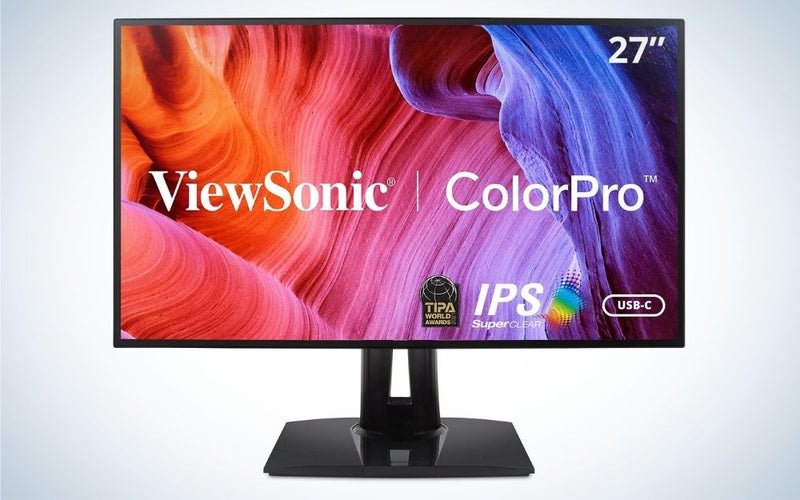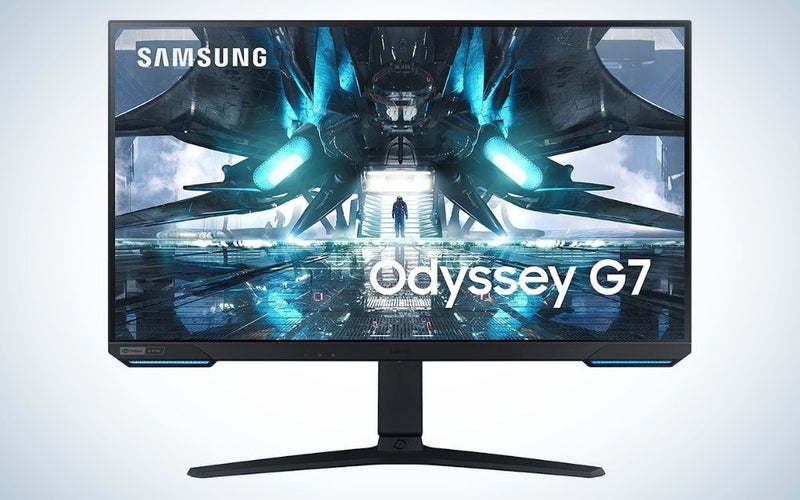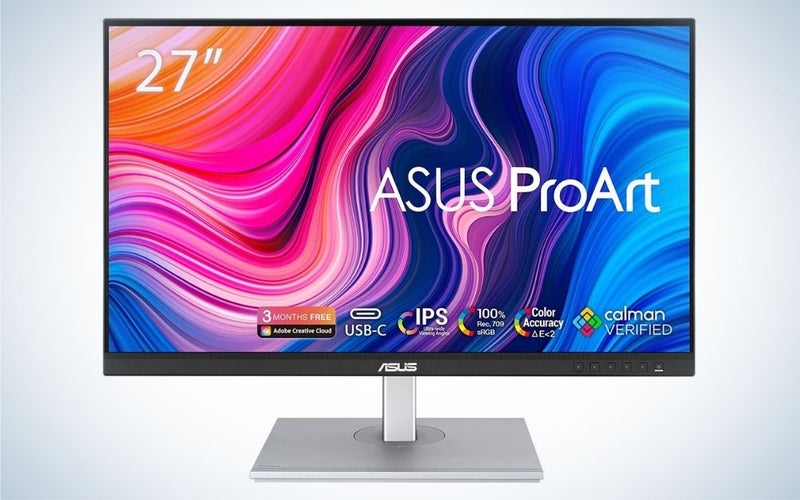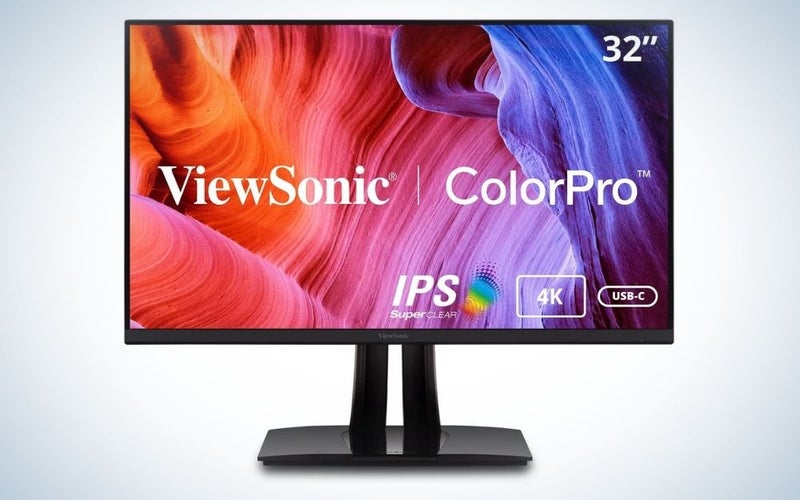We may earn revenue from the products available on this page and participate in affiliate programs. Learn more ›
While displays are typically shown in horizontal orientations, vertical monitors can be useful tools. The portrait orientation is ideal for extensive coding work, working on print layouts, or for reading lots of material. Having the option to rotate your display on its side may also be helpful for editing vertical photos, as you’ll see your photo in a larger size. No matter what you plan on using it for, the beset vertical monitors will help you get the most out of your display and improve your viewing experience.
- Best overall: LG 27UN850-W Ultrafine
- Best budget: HP VH240a 23.8-Inch monitor
- Best for productivity: ViewSonic VP2768a ColorPro 27 Inch monitor
- Vertical gaming monitor: Samsung Odyssey G70A 28-Inch gaming monitor
- Best 27-inch: ASUS ProArt Display
- Best 32-inch: ViewSonic VP3256-4K 32-Inch display
How we chose the best vertical monitors
We started by considering dozens of different monitor options and narrowed them down to those with vertical stands or at least VESA mounting holes. I have been a professional photographer and camera writer for more than 15 years and have used dozens of monitors from every manufacturer. I typically keep a vertical monitor on my desk to keep Slack and Tweetdeck visible at the same time while I do work on my main display. For this list, we focused on models that offer solid performance, whether they’re horizontal or vertical, because you never know when you’re going to want to switch up your setup.
The best vertical monitors: Reviews & Recommendations
With the features out of the way, it’s time to dig into our picks for the best vertical monitors. While we recommend specific use cases for each of these models, they’re all proven solid products and there’s absolutely some overlap in usability.
Best overall: LG 27UN850-W Ultrafine
LG
Why it made the cut: High-resolution, excellent color accuracy, and a flexible stand make this one of the best vertical monitors overall.
Specs:
- Size: 27 inches
- Resolution: 3840 x 2160
- Refresh rate: 60Hz
Pros:
- 4K resolution
- Excellent overall picture quality
- Factory calibration
- Accurate color
- Adjustable stand
Cons:
- A little pricey
Unless you plan on doing heavy duty gaming, LG’s 4K monitor has just about everything a person could want out of a display. It covers 99 percent of the sRGB color space, which makes it capable enough for creative work.
The package includes one of the most versatile stands around. It moves up and down, tilts, and rotates 90 degrees so it can work in a horizontal or vertical orientation. Flip the panel over and you’ll find a VESA 100 x 100 mount, which is extremely common and opens up a ton of arm and stand options.
It only has a 60Hz refresh rate, but at this price, you’re not going to find a ton of monitors that offer solid color performance and 4K resolution. A built-in USB-C port delivers 60W of power so it will fast charge devices. This is a great all-around option that easily flips vertical when you want it.
Best budget: HP VH240a 23.8-Inch monitor
HP
Why it made the cut: If you don’t need a huge monitor, you can save some serious cash and still get excellent image quality.
Specs:
- Size: 23.8 inches
- Resolution: 1920 x 1080
- Refresh rate: 60Hz
Pros:
- Stand freely rotates for vertical use
- VESA mounting holes
- Affordable
- Built-in speakers
Cons:
- Low-res may be a turn off for some
HP’s budget-oriented monitor tops out at 1080p resolution, but if you’re just using this for code or as a secondary display, that may not be an issue for you. At 23.8 inches, it won’t take up a ton of space on your desk or look totally ridiculous when used alongside a laptop.
In addition to its 90-degree rotation, it offers height adjustments as well as -5 to +30 degrees of tilt to help find the ideal viewing position and angle.
Despite its low price, the screen isn’t overly glossy, which can be an issue with models in this range. That helps cut down contrast-stealing glare.
Best for productivity: ViewSonic VP2768a ColorPro 27 Inch monitor
ViewSonic
Why it made the cut: Excellent color management from this IPS panel makes it great for creative work.
Specs:
- Size: 27 inches
- Resolution: 2560 x 1440
- Refresh rate: 60Hz
Pros:
- Exceptional color performance
- Excellent size and resolution combination
- VESA mount
- Versatile stand
Cons:
- You can move up to 4K, but it adds to the cost
This is the monitor I use every day for a lot of my professional work. It’s an IPS display, which ensures that the colors and illumination stay accurate and consistent all the way to the edge of the screen.
The factory stand allows you to adjust the height, tilt, and of course, the rotation of the display on the fly so it’s simple to switch orientations.
Attach the monitor to a computer using the USB-C port and it powers a pair of USB-A ports on the device itself for plugging in peripherals. It also offers a headphone jack, HDMI, DisplayPort and an ethernet port. It comes color calibrated from the factory, which I’ve found to be surprisingly accurate. It’s a great option if you want a vertical monitor to proof portrait-oriented images or just keep color palettes and other editing tools off to the side while you concentrate on your photos and videos on the main screen.
Vertical gaming monitor: Samsung Odyssey G70A 28-Inch gaming monitor
SAMSUNG
Why it made the cut: A 144Hz refresh rate and super-fast response time make this great for gaming.
Specs:
- Size: 28-inch
- Resolution: 3840 x 2160
- Refresh rate: 144Hz
Pros:
- Wide 21:9 aspect ratio is good for gaming or extra-long scrolls
- Smooth motion thanks to the high refresh rate
- VESA 100 mount
- Wall-mountable with an adapter
Cons:
- Might be too vertical for some users
- Not every user will need the gaming features that push up the price
Creatives demand a lot out of our monitors, but gamers can be even pickier. This 28-inch monitor employs a 21:9 aspect ratio, which is wider than a typical display. When turned sideways, that makes it particularly tall, which is desirable to some coders or Discord mavens.
When it comes to its gaming chopes, the display promises a 144Hz refresh rate, which means the on-screen image refreshes more than twice as many times per second as a typical display. That leads to smoother action in everything from high-end gaming to simple scrolling. Nvidia’s G-Sync tech keeps the monitor’s refresh rate in sync with the graphics card in an effort to avoid image tearing and other undesirable effects.
While this monitor has serious gaming chops, it also works for every day tasks. Its color management isn’t perfect for creative work, but you can easily calibrate it with a cheap device if you want to lock things in.
Best 27-inch: ASUS ProArt Display
ASUS
Why it made the cut: Asus put a lot of effort into getting the ProArt colors right straight from the factory.
Specs:
- Size: 27 inches
- Resolution: 2560 x 1440
- Refresh rate: 75Hz
Pros:
- Great color right out of the box
- VESA mount
- Flexible stand
- Sharp, clear picture
- Easy to daisy chain multiple monitors
- Built-in USB hub
Cons:
- While versatile, the stand doesn’t feel super sturdy
We consider this the best Asus monitor around, so it only makes sense for it to show up on this list of the best vertical monitors. It comes out of the box calibrated from the factory, which means you can do serious creative work on it right away. It covers 100 percent of the sRGB color space as well as 100 percent of the Rec 709 wide color gamut, which is impressive for a model at this price.
The stand allows for free rotation, height adjustments, and tilt, but it doesn’t feel quite as solid as some of its competition. If you want to skip the factory stand completely, VESA 100 compatibility opens up a ton of other options in terms of arms and stands.
It also offers a heap of extra connectivity features, including USB-C with 65W Power, DisplayPort, HDMI, USB 3.1.
Best 32-inch: ViewSonic VP3256-4K 32-Inch display
ViewSonic
Why it made the cut: This is simply a larger version of an already excellent monitor.
Specs:
- Size: 32 inches
- Resolution: 3840 x 2160
- Refresh rate: 60Hz
Pros:
- Great color right out of the box
- VESA mount
- Flexible stand
- Sharp, clear picture
- Easy to daisy chain multiple monitors
- Built-in USB hub
Cons:
- Pricey
If you’re still convinced that 27 inches isn’t enough space for you, Viewsonic offers a 32-inch 4K version of our best-for-productivity pick. It’s still great when it comes to color. It handles 100 percent of the sRGB space as well as 95 percent of the Adobe RGB gamut. This monitor goes one step beyond its little sibling, too, by offering Pantone certification, which comes in very handy if you’re a designer or just a verifiable color nerd.
This is a big display with a ton of pixels, so make sure you have space for it if you’re planning to use it vertically. It might tower over your horizontal monitor, especially if you’re using a laptop.
Things to consider when shopping for the best vertical monitors
Even if you’re looking for a secondary monitor instead of a main display, you’ll want to choose carefully. After all, we spend hours at a time staring at these glowing screens, we might as well make sure that we choose the right ones. Here are some factors consider when you’re out searching for the best vertical monitors.
Usage
Why do you even want a vertical monitor? It’s a valid question. After all, horizontal screens have dominated for decades. Now, we have elaborate photo editing programs, endless social media to scroll through, and tons of Discord channels to keep track of throughout the day. If you’re just looking for something to scroll social with, you don’t need to spend a ton of cash. The same goes for a display meant for chat programs. If you’re going to integrate this vertical screen into your editing process, however, you’ll want to spend a little extra money to get features like an IPS monitor, wider color space support, and higher-resolution.
Mounting options and stand
Almost every monitor can display a vertical picture, but it’s not much use to you if you can’t mount it correctly. Most of the displays on this list come with stands that allow them to turn sideways without any extra effort or hardware.
These monitors also typically include VESA mount certification. VESA monitors have four holes in the back of the panel that allow it to mount to a variety of different stands or arms. If you see VESA and then a number, that indicates the number of millimeters between the holes and lets you know what kind of bracket to look for when purchasing a mount.
Size
As with typical monitors, it’s not as simple as choosing the biggest one you can afford and slapping it on your desk. Before you can choose the best vertical monitor size for you, you’ll need to consider your setup. 32-inch monitors have become relatively common for main displays, but they can feel enormous when you rotate them vertically. I find 24 inches and maybe 27 inches the current sweet spot. Going with a monitor larger than that starts to make my desk feel ridiculously crowded. This need will differ for every user, so consider how much space is on your desk and how much it will require you to turn your neck to look at an enormous screen.
Resolution
As with size, you may not need to go as wild on resolution as you did with your main display. You can still get a lot of usable space out of a plain old 1080p monitor if you’re turning your screen vertically. Of course, opting for a higher-resolution model will give you more screen real estate to play with as long as you don’t mind objects on the display getting fairly small. Higher-resolutions can be handier for people using the vertical monitor for editing instead of reading social media or Discord.
Ports
Modern monitors offer more than a picture on a screen. They also often include an array of additional ports, including USBs, Display ports and HDMIs for daisy chaining multiple monitors together, and even headphones jacks.
With the best vertical monitors, the location of these ports matters more than it does with a horizontal arrangement. You may not want a whole bunch of wires sticking straight out of the side of your monitor. Check the location of the ports before making a purchase.
FAQs
Q: When should you use a vertical monitor?
Lots of people use vertical monitors for a whole variety of reasons. Coders love them for the extra scroll. Gamers often rely on them for Discord. Creatives rely on them to get full-sized views of images in portrait orientation or just as a place to dump tools and palettes. There are tons of options and they’re worth exploring.
Q: Do all monitors have portrait mode?
The vast majority of monitors will allow you to turn the image sideways, but not every model offers the stand or mounting options you need to keep it vertically. Look for something with a stand that flips 90 degrees or a VESA mount that opens up your options.
Q: What are the benefits of a vertical monitor?
Some images, websites, or apps operate in a vertical orientation. Even if you don’t want one long program on your screen, you can put two applications directly on top of each other and still get more stuff on the display than you would in horizontal orientation. It’s not for everyone, but once you try it, you may never go back.
Some final thoughts on the best vertical monitors
- Best overall: LG 27UN850-W Ultrafine
- Best budget: HP VH240a 23.8-Inch monitor
- Best for productivity: ViewSonic VP2768a ColorPro 27 Inch monitor
- Vertical gaming monitor: Samsung Odyssey G70A 28-Inch gaming monitor
- Best 27-inch: ASUS ProArt Display
- Best 32-inch: ViewSonic VP3256-4K 32-Inch display
For the most part, everything that makes a good horizontal monitor also applies to their vertical counterparts. LG and Viewsonic make two of the best options around that are affordable enough for the average user, but capable enough for professional creative work. I still use the Viewsonic on this list every day as my main monitor and don’t plan on changing in the near future.
Why trust us
PopPhoto has a long history of delivering the opinions of some of the sharpest and most prolific camera dorks the world has to offer. Since 1937, we’ve been reviewing cameras, providing wisdom from well-known photographers, and generally just nerding out about all that goes into making great pictures. Our current crop of writers and editors have decades of professional photography and camera writing experience among them. Collectively, we’ve probably shot with just about every camera and lens combo you can imagine—as well as some obscure stuff you may not even know about. Remember the Casio Tryx folding camera? PopPhoto does.
We also get that buying a camera is a big decision, which is why we’re dedicated to helping folks choose the right one (or, in our case “ones”) for their needs. Case in point: Handing over top dollar for an expensive rig may leave you unsatisfied if it doesn’t fit your preferred shooting style. Sure, a $6,000 sports-oriented DSLR can capture landscapes, but do you really need to do it at 30 frames-per-second? No, you don’t.
